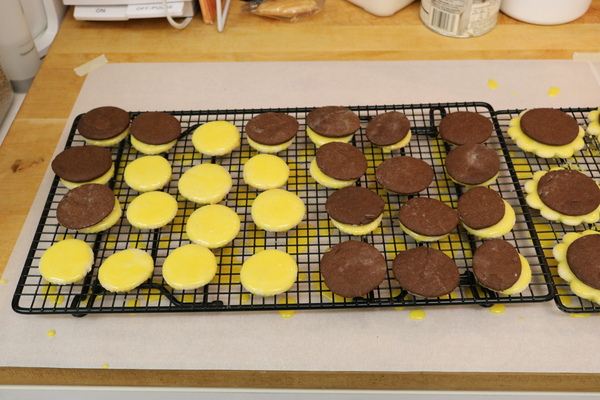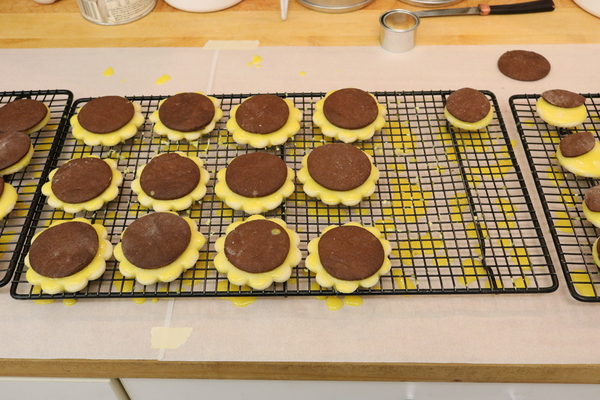Forum Replies Created
-
AuthorPosts
-
Here are some pictures of the assembled cookies. I added a link to the sugar cookie recipe we used to the lead post in this thread.



My wife (a certified HS math teacher) completely agrees with her. She has a 'Math is Fun' T-shirt that she got at a regional math conference.
Baked the eclipse cookies yesterday and today.
Yesterday was our test day, today was production day, I baked 5 pans full of cookies and one partial. Assembly is next, then I'll take and post some good pictures. We did take a plate of cookies across the street to our new neighbors who have 3 young kids (the oldest girl is 11, about the age of our granddaughter.)
Most of the cookies will be going in to my wife's office in the morning. Some will be in her office for faculty and staff, the rest will be on the snack table that they set up every fall to welcome students back on the first day of classes.
I haven't ordered the powdered cheese at nuts.com, because I find their prices not very appealing, but I have ordered the powdered cheese at bulkfoods.com, it's very similar to the cheese powder you got in Kraft Mac & Cheese before they reformulated it a few months ago to get rid of the artificial food colors. (I would order it again, too.)
They were selling giant eclipse cookies at the grocery store, just a big circular cookie with chocolate covering like 7/8 of it.
I wish I'd thought of these a few weeks ago, I might have entered them in the 'sandwich cookie' category at the Lancaster County Fair.
Be VERY careful looking at the eclipse on Monday, there's a story in today's Lincoln paper about someone who used a welder's helmet during a partial eclipse in 1963 and suffered some permanent vision loss.
Even with ISO-certified glasses, limit the time you're viewing it. I have a 100K solar filter for my camera, I did some test shots today, it looks it'll do a pretty good job showing the progress of the eclipse. I'll take the filter off for some shots during totality, which will last about 80 seconds here.
Of course this all assumes the weather cooperates on Monday. Our current forecast is 'partly cloudy'.
Our first test batch is out. We tried a few different methods, in the next batch we will be baking the sun and various degrees of eclipsing moon cookies separately, gluing them together with some yellow lemon icing. (I have some KAF powdered lemon extract that works very well for this.) That has the advantage that we can do a tray of one then a tray of the other, the sugar cookie recipe we're using gets soft really fast. My wife also wants to try dipping the chocolate cookies in icing to create the eclipse effect, I'm skeptical of that.
We're tried a fluted round cookie cutter for the first batch of suns, but the flutings are so small that you can't really see them under the icing, so we're going to try some scalloped edge cookies in the next batch.
I'll try to include some photos later today.
I have used the pasta roller attachment for my KA mixer once or twice to make cracker dough, it worked reasonably well. It isn't very wide but for crackers that's not an issue.
I have made crackers a few times, never thought they were worth the effort it took. A sourdough cracker sounds interesting, but with my wife's problems with sourdough, I don't have a starter to work with.
I think if you ate a slice without knowing the ingredients list, you'd never guess it had malted milk powder in it.
Rascal, have you tried the Austrian Malt Bread recipe? That's the one that my son said was more like white bread than white bread.
I generally divide the Double Crusty dough into two or three parts, shaping them into torpedo-shaped loaves and baking them on a parchment-lined sheet pan. These days I've been making two loaves, cutting both in half when cool, and freeing 3 halves.
I'd welcome some threads on kitchen design, there were some good ones back on the KAFBC.
We spent a lot of time designing our kitchen. The counters and cabinets are all deeper than the standard, the top drawer under each counter has a pull-out so there's expandable work surface area, there are multiple types of surfaces (butcher block, granite and marble) at several different heights. (I could use an even higher counter for some tasks, I've been tempted to buy a 24x36 butcher block that is at least five inches thick to build up an area for my baking work, as I'm 5 inches taller than my wife, but it'd cost at least $500 and would weigh at least 40 pounds.)
One thing I wish we had added is some kind of stainless steel surface next to a sink for easy cleanup after doing something like cutting up a chicken.
The floor surface is another area where I MIGHT have done something different. We put in a slate surface tile, because we were concerned that a smooth surface tile might get too slippery. The problem is that the surface has lots of little places where dirt collects. A steam cleaner seems to be the best solution for keeping the tile clean. I've considered ordering commercial kitchen mats a few times.
The overall kitchen dimensions are 17 x 18 feet, with a center island that has a prep sink on one side and an electric cooktop on the other. There's also a dual fuel 48" range on one wall.
The home kitchen design 'experts' spend a a lot of time talking about the 'work triangle' but commercial kitchens follow different rules, as one of their goals is to have multiple work areas so several people can be working at once. (If you do a good job with mise en place, it doesn't matter whether the refrigerator and freezer are 2 steps away or 10.) We once hosted a party with 3 professional chefs doing the catering, they loved our kitchen!
Good luck on your kitchen remodeling project, they always take longer than you want them to. The house across the street from us was recently bought by a young couple and they're redoing the kitchen and a bunch of other things. (The house was built in the 60's and nearly every room on first floor has a step up or step down from another room, they have--or will soon have--little kids so all those steps have to go.) They were hoping to be done by the end of July, but I think the contractor is still working on stuff. And now the house next to theirs is apparently undergoing some changes. (Both the owners have passed away in the past year and the house needs a lot of updating, plus it may have termite issues, several of the houses in this neighborhood do.)
-
AuthorPosts